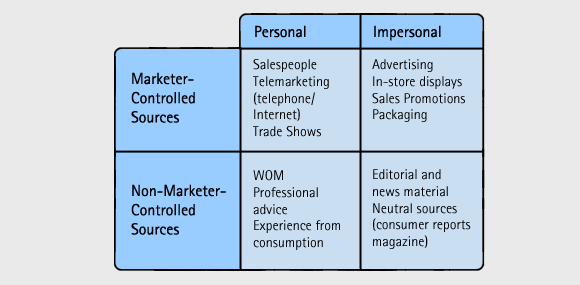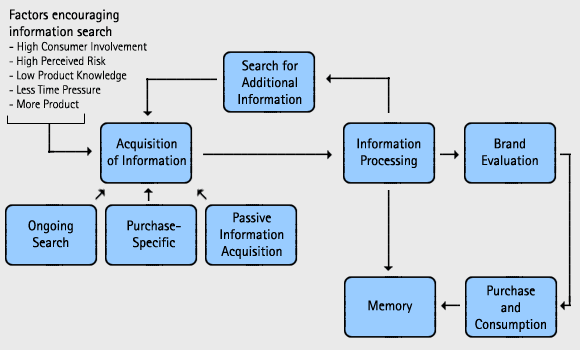| Every day the average consumer is exposed to approximately
1,500 commercial messages. With increasing competition for consumers'
attention, grasping how consumers process information is indispensable
for marketing practice. Important marketing objectives, such as
increasing sales or brand awareness depend on how well consumers
understand and retain relevant information. As a general rule
of thumb, it is expected that consumers will actively look for
information regarding a product or service when the risks of making
a wrong decision are high.
Perceived risks
There are five types of perceived risk.
- Financial risk: Based on the cost of a product relative to
a consumer's disposable income.
- Social risk: Is a function of whether or not the product purchased
will be accepted by relevant others.
- Psychological risk: Based on the degree to which a product
or service is in accordance with a consumer's values and self-concept.
- Performance risk: Related to the likelihood a product or service
will function as it is expected to.
- Physical risk: The probability that a product or service can
be hazardous to a consumer's wellbeing.
Sources of information
Most purchases involve some level of risk and therefore require
consumers to search for information. Consumers have many sources
of information that they can look for. These may be arranged as
either personal/impersonal and either marketer controlled/non-marketer
controlled sources. Figure 8.1. demonstrates the range of sources
of information that a consumer may use. These sources are important
for a marketer to consider because where a consumer can easily
make use of personal, non-marketer controlled sources the influence
that the marketer has on any subsequent decision is very small.
| Figure 8.1 Consumer sources of
information |
|

| Source: Adapted from Robertson, T.S., Zienlisnki,
J. and Ward, S. (1984) |
|
Information acquisition model
Information search is a complex aspect of consumer behaviour.
The Information Acquisition Model summarises relevant aspects
of why and how consumers search for information.
| Figure 8.2 Consumer information
search |
|

|
Example to illustrate Figure 8.2
A. Factors encouraging information search
High Consumer involvement: Jennifer is organising a surprise
party for her 18-year-old daughter. Where to celebrate the party
is a very important decision for her because she believes that
a memorable party will demonstrate how much she loves her daughter.
High Perceived risks: Jennifer is worried because she wants to
take the whole family to an exotic destination; this will be a
significant financial commitment (financial risk). She is also
concerned with satisfying everybody's expectations (social risk)
and ensuring that the trip is a safe one (physical risk).
Low product knowledge: This is the first time Jennifer has organised
a trip of this nature. In fact, she hasn't travelled abroad before.
Less time pressure: Jennifer has 10 months to organise the trip,
so she has plenty of time to look for alternatives.
More product differences: Numerous travel operators sell packages
to an even greater number of •exotic destinations', Jennifer finds
it difficult to decide which destination is more suitable and
what operator offers the best deal.
B. Information acquisition
Jennifer is actively looking for information that will help her
with her choice (purchase specific). In this case, where the objective
is time specific, the information search is unlikely to be ongoing
or passive.
C. Information processing
Once Jennifer has collated enough material she will process all
the information, storing relevant facts in her short and long-term
memories. At this stage she could decide that more information
is needed and resume her search for information.
D. Brand evaluation
Once the information has been digested, Jennifer will have to
evaluate the travel operators she is considering.
E. Purchase and consumption
Jennifer will purchase her dream holiday package from one of the
tour operators. She will experience the holiday and will then
assess whether her expectations were met or not. E. Memory This
direct experience will now form an important part of what Jennifer
stores in her long-term memory and retrieves in future situations
when she is faced with similar purchase decisions.
|

